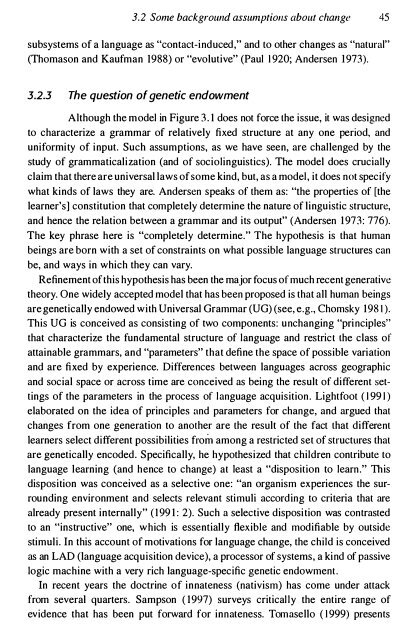Gram - SEAS
Gram - SEAS
Gram - SEAS
You also want an ePaper? Increase the reach of your titles
YUMPU automatically turns print PDFs into web optimized ePapers that Google loves.
3.2 Some background assumptions about change 45<br />
subsystems of a language as "contact-induced," and to other changes as "natural"<br />
(Thomason and Kaufman 1988) or "evolutive" (Paul 1920; Andersen 1973).<br />
3.2.3 Th e question of genetic endowment<br />
Although the model in Figure 3.1 does not force the issue, it was designed<br />
to characterize a grammar of relatively fixed structure at any one period, and<br />
uniformity of input. Such assumptions, as we have seen, are challenged by the<br />
study of grammaticalization (and of sociolinguistics). The model does crucially<br />
claim that there are universal laws of some kind, but, as a model, it does not specify<br />
what kinds of laws they are. Andersen speaks of them as: "the properties of [the<br />
learner's] constitution that completely determine the nature of linguistic structure,<br />
and hence the relation between a grammar and its output" (Andersen 1973: 776).<br />
The key phrase here is "completely determine." The hypothesis is that human<br />
beings are born with a set of constraints on what possible language structures can<br />
be, and ways in which they can vary.<br />
Refinement of this hypothesis has been the major focus of much recent generative<br />
theory. One widely accepted model that has been proposed is that all human beings<br />
are genetically endowed with Universal <strong>Gram</strong>mar (UG) (see, e.g., Chomsky 1981).<br />
This UG is conceived as consisting of two components: unchanging "principles"<br />
that characterize the fundamental structure of language and restrict the class of<br />
attainable grammars, and "parameters" that define the space of possible variation<br />
and are fixed by experience. Ditl"erences between languages across geographic<br />
and social space or across time are conceived as being the result of different settings<br />
of the parameters in the process of language acquisition. Lightfoot (1991)<br />
elaborated on the idea of principles and parameters for change, and argued that<br />
changes from one generation to another are the result of the fact that different<br />
learners select different possibilities from among a restricted set of structures that<br />
are genetically encoded. Specifically, he hypothesized that children contribute to<br />
language learning (and hence to change) at least a "disposition to learn." This<br />
disposition was conceived as a selective one: "an organism experiences the surrounding<br />
environment and selects relevant stimuli according to criteria that are<br />
already present internally" (1991: 2). Such a selective disposition was contrasted<br />
to an "instructive" one, which is essentially flexible and modifiable by outside<br />
stimuli. In this account of motivations for language change, the child is conceived<br />
as an LAD (language acquisition device), a processor of systems, a kind of passive<br />
logic machine with a very rich language-specific genetic endowment.<br />
In recent years the doctrine of innateness (nativism) has come under attack<br />
from several quarters. Sampson (1997) surveys critically the entire range of<br />
evidence that has been put forward for innateness. Tomasello (1999) presents
















